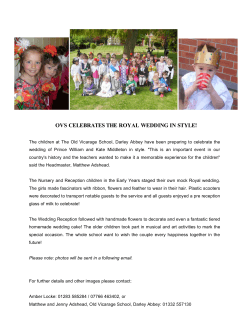
We and Our World - dav centenary public school, tohana
WE AND OUR WORLD (Class-IV) Publication Division D.A.V. College Managing Committee Chitra Gupta Road, New Delhi-110055 CONTENTS S.No. Topic Page No. 1. Family Relationships 1 2. Sensitivity Towards Others 11 3. Celebrating Our Diversity 18 4. An Ideal Home 27 5. Bricks and Bridges 34 6. Waste Management 44 7. The Works We Do 53 8. Leisure Time 62 9. Directions 69 10. Travel and Tours 79 11. Let Us Travel 88 12. Let Us Communicate 97 13. India—Our Motherland 108 1 Family Relationships I am Angad. I live with the members of my family. They give me love and affection. I share my thoughts and feelings with them. Whenever I am in doubt, I ask my parents, grandparents, uncles or aunts for advice. Sometimes, my siblings or cousins come up with the best advice to make a decision. Do You Know? Foster children are not adopted but live with the family for a fixed period. A ‘family’ consists of a married couple and their children, both natural (born to that couple) and adopted. Family members share a common residence and surname. Some members of a family may live away from their family home for education, jobs, etc. Do You Know? The needs of the members are fulfilled by a family. It looks after the children as well as the sick and the old members. All family members love and respect one another. Family is the first school where the child learns the Do’s and the Don’ts of the society. 1 The family members share the Do You Know? household chores. The sharing ‘Singh’ is the surname of reduces the burden on any one family Angad’s family. member and encourages responsibility. Angad’s father, Sunny Singh and mother, Nidhi Singh look after the family business. His brother, Aadit Singh takes him to the park in the evening. His grandmother, Dr. Promila Singh, helps him with his homework and looks after the health of all family members. She also narrates wonderful stories about great people, places and events. Angad’s grandfather, Mr. Kawaljeet Singh, buys vegetables and fruits for the family. He takes the children to school and for nature walks. The children learn good behaviour, moral values and skills by watching the members of the family. The older family members automatically pass on values and family traditions to the younger generation. The children learn to talk politely, greet guests and respect Do You Know? Many children inherit talents from their family members. A child may sing melodiously like a parent, an uncle or a grandparent. 2 their elders. They learn how to arrange their books and toys, sew buttons, fold their clothes, polish their shoes and lay the table for family meals. They also learn family crafts like weaving, painting, jewellery making, pottery, etc. Joint Family A joint family has parents and their married children living together. It consists of a number of nuclear families living under the same roof. Mostly, they share a common kitchen and hold a common property. Sharing space teaches the children cooperation, living in harmony and caring for the members of the family. Indu’s father died in a road accident in Dibrugarh (Assam). Indu and her mother shifted to Meerut to live with her father’s parents. Indu’s mother was not trained for any job. She learnt computers and office management. Now she works in an office. Indu’s grandfather, who was a National Level Swimmer, teaches her swimming. During the summer vacation, he takes all his grandchildren to the swimming pool and coaches them. Indu enjoys her cousins’ company! 3 Nuclear Family A nuclear family consists of a married couple and their unmarried children. In a nuclear family, the parents and siblings provide all the support, companionship and advice to the children, as their cousins, uncles, aunts or grandparents do not live with them. There is greater interaction among the parents and the children in a nuclear family. Angad’s uncle works in a bank. He has been transferred to Ladakh. His wife and two children are also going with him. The whole family is feeling very sad. Angad’s uncle, Sandeep and his wife, Priya rent a house in Ladakh. Their children Riya and Vikas miss their grandparents, uncles, aunts and cousins. Their parents are helping them to adjust to a nuclear family. Angad’s friend—Parth Angad went to Parth’s house to see his baby sister—Shweta. Parth told him that she grew up in his mother’s body. She was delivered in a hospital and brought home. Angad wondered where she would sleep and what she would eat! 4 Changing Family System in India Do You Know? The family system is changing very All the family members get fast. Joint family system, which was together for celebrations like very strong in India, is changing as weddings, festivals and the people are moving to different parts of birth of a child. the country and the world. They migrate to other places in search of better jobs and educational opportunities or suitable climate. In earlier times, most people were engaged in agriculture. It required many hands that were available in a joint family. But the income from land was not sufficient for increase in the size of families. Hence, some members moved to cities for employment in various fields. Nuclear families became common in rural areas. Even in urban areas the number of nuclear families increased as many members moved to other cities or countries for education, employment, climate, etc. Whatever the type of family may be, each member of the family is important. A family provides an environment of care, protection, love and belongingness. Do You Know? Family unity can be encouraged in following ways: (a) Treat all the members with respect. (b) Forgive and forget. (c) Spend quality time together. 5 Something to Know A. Tick (✓ ✓ ) the correct option: 1. What do all the family members share in common? (a) Toys (b) Rooms (c) Surname 2. Who provides all the support to children in a nuclear family? (a) Uncle and Aunt (b) Parents and siblings (c) Both 3. Where do you get an environment of love, care and belongingness? (a) Market (b) Family (c) Garden 4. People move to the different parts of the world for— (a) Job (b) Education (c) Both B. Fill in the blanks: Help Box support, joint, chores, important, respect one another. 1. All the family members love and 2. The family members share the household 3. A . family has parents and their married children. 4. In nuclear family, parents provide , companionship and advice to the children. 5. Each member of a family is . 6 C. Match the following: 1. Family (a) parents and children 2. Adopted child (b) weaving, painting, pottery 3. Nuclear family (c) care, protection, belongingness 4. Family crafts (d) many nuclear families 5. Joint family (e) permanent member D. Correct the following sentences: 1. Sharing of chores increases the burden. 2. The older family member pass on the family traditions to the older generation. 3. There is less interaction between parents and children in nuclear families. 4. A surname is a school name. E. Answer the following questions: 1. What is a family? Name two types of families. 2. Mention the things children learn by watching the family members. 3. Differentiate between a joint family and a nuclear family. 4. What are the advantages of sharing your home with other members of family? 5. State two reasons that are responsible for changing family fibre in India. 7 ALUE Based Question: Each member of a family is important, unique and has special qualities. What special qualities of your family members do you admire and appreciate? Map Skill Look at the political map of India. Trace the boundaries of the following: • Delhi • Uttar Pradesh • Jammu and Kashmir • Assam • A state that you want to visit. 8 Something To do 1. Discuss with your parents and list five moral values that are important for every person— (a) Truth (b) (c) (d) (e) 2. Extended family includes paternal and maternal families. Meet your extended family and fill the following: (a) Your father’s brother’s/sister’s name (b) Your mother’s brother’s/sister’s name (c) Your cousin’s name (d) Your grandfather brother’s/sister’s name (e) Your grandmother’s brother’s/sister’s name 3. Prepare a family album. Write down a small poem or few lines about any three family members. 4. Family celebrations are a time of enjoyment for all the members of a family. Name a family celebration that you enjoy the most and explain the reason for the same. 5. The size of the family increases with the birth of a baby or by marriage. There must have been a marriage or a birth of a baby in your family in recent years. How do you address the new member? 9 6. See your old family album or talk to your grandparents. Compare the house in which they lived when they were your age, with the house you live now. Basis Then Now Area (Urban/Rural) Size Number of members Materials used 7. Riddle Game (a) He is your father’s father but is your . (b) She is your mother’s niece but is your (c) Your sister’s aunt is your . . (d) Your maternal grandparents only daughter is your (e) He has the same parents, he is your 10 . . 2 Sensitivity Towards Others Meena saw her nine-year-old son, Anand, making a painting. She was curious to know who was going to get this piece of art. Her son told her that it was for his classmate’s little sister, who was a special child. The entire class was busy making cards, paper chains, caps and masks for her fifth birthday to make her happy. The little girl was unable to walk, speak or hear but conveyed her happiness by smiling or clapping. Anand’s answer filled Meena’s eyes with tears. She could not believe that Anand, who refused to share his toys with his own younger sister, Usha, could be so concerned about bringing joy to a special girl. Meena felt proud of her son. We live in a society. All of us Do You Know? depend upon one another for different reasons. Look around and you will find A society is an organised that most people are sensitive to the group of people. needs of others. Everyone is ready to hold the hand of a child and an old person while crossing a road, offer them a seat in a bus or a train; or help them to carry heavy bags. 11 The children develop a caring attitude towards others by watching their parents and other people around them. Children learn many things from their friends also. Let us take the example of Neeta. She lives in a joint family where everyone cares for the comfort of others. She plays quietly when her grandfather rests. All the neighbourhood children have also become conscious and do not make noise while Neeta’s grandfather is sleeping. Activity: List two good habits that you have learnt from your friends. Vasudha is a successful fashion designer. Her mother works in an office and her father is a bank officer. Every morning, Vasudha bathes and feeds her grandmother, Shanti Anand, before going to the office. In the evening, she cleans and feeds her again. Her parents feel proud of her caring behaviour towards her grandmother. They appreciate her help. However, they had never forced Vasudha to take care of her grandmother. She had observed her parents and naturally developed a sense of responsibility towards her grandmother. Family plays an important role in building strong bonds of love and care. All children share a special bond with their grandparents. They gladly run to get spectacles, medicine or anything that their Do You Know? Many old people become hard of hearing and cannot see properly, therefore, it is very important to assist them in their day-to-day activities. 12 grandparents want. On the other hand, the grandparents love their grandchildren very much and never forget to buy them gifts like their favourite fruit, toy, storybook, etc. They are very happy to take the grandchildren to school, park or some other place of their choice. Living in a Quiet World Anjali was born deaf. She cannot hear the noise, the sounds or people talking. She does not know what it is like to hear but she knows what it is like to be deaf. It is quiet everywhere. When she uses her hearing aid, the vibrations of the loud sound disturb her. She quickly turns off her hearing aid! Hearing impaired (deaf) children are taught the sign language. It is an organised system of gestures or mime, used in place of speech. It is common among people who do not speak a common language or among people who are unable to speak or hear. The diagram shows the hand movements used in finger-spelling or sign language. Each movement symbolises a letter of alphabet. They are used together with gestures for specific words or ideas, which enable a hearing impaired person to converse with others. Sign Language In earlier times, most people Do You Know? believed that hearing impaired people were incapable of learning a Deaf people are also trained to language or of being educated in make sounds and read the lip movements so that they can any way. But Pedro de Ponce, a communicate with others. Spanish monk, became the first teacher to teach such students. In 1620, Juan Paulo Bonet, another Spanish, wrote the first book for educating them. The book contained a manual alphabet similar to the one used today. 13 Living in a Dark World The visually impaired (blind) people learn to use their sense of ‘touch’ to feel and anticipate. They read books that are different from ours. The pages of their books are thick and have rows of raised dots. These books are written in Braille. They touch these dots and recognise the written word. Thus, they read by running their fingers on them. Do You Know? Braille was invented by Louis Braille. In an accident, he lost his eye-sight. He had great interest in reading which persuaded him to find the ways of reading and writing. Finally, he introduced a way to read and write—by touching the raised dots on paper. This script was named Braille in his honour. Louis Braille The hearing impaired or the visually impaired children deserve our understanding and not pity. They do not have the ability to hear with their ears or see with their eyes, but they can be guided to move around on their own like other people. They can study and work hard at different occupations/professions. They can prove to be useful members of society, if they are given proper facilities, opportunity and guidance. We must give them respect. Never be afraid to ask if they need any help. How to Develop Sensitivity Towards Others 1. Respect the elders. 2. Do not make unkind remarks about anyone’s physical appearance like children wearing braces, special shoes, spectacles, etc. 3. Do not make negative remarks about anyone’s religion, caste, language, etc. 4. Talk politely to younger children, older people and everyone; especially the servants. 5. Try to participate in different activities. Participation is more important than winning. 6. Have sympathy for the poor and those suffering from any disease. 7. Share the household chores. 8. Learn about meditation. It develops an ability to handle stress. Good citizens are, after all, made at home! 14 Something to Know A. Tick (✓ ✓ ) the correct option: plays an important role in building confidence. 1. (a) Family (b) Neighbourhood (c) Television 2. Who needs our help more? (a) Hearing impaired (b) Old people (c) Both 3. Where are good citizens made? (a) Parks (b) Cinema halls (c) Home 4. How do children develop sensivity towards others? (a) Watching films (b) Reading books (c) Watching their parents B. Fill in the blanks: Help Box depend, participation, sign, bond, parents on one another for different reasons. 1. In a society all of us 2. Most children develop kind and caring attitude by watching their . 3. All children share a special with their grandparents. 4. Hearing impaired children are taught 5. is more important than winning. 15 language. C. Match the following: 1. Visually impaired (a) relieves stress 2. Hearing impaired (b) bonds of love 3. Family (c) opportunities 4. Special children (d) use of touch 5. Meditation (e) sign language D. Answer the following questions: 1. Why is it important to help others? Explain with an example. 2. ‘‘We develop an understanding for others in the society for a harmonious living.’’ Explain. 3. How can you respect the feelings of the hearing and visually impaired children? 4. What is ‘sign language’? 5. How can the special children grow into useful members of the society? ALUE Based Question: Raju was not able to walk or talk. He joined a special school where his mother carried him on her back. His teacher, Brij Sir, taught him to read and write. It was very difficult for him but his classmates, his physiotherapist, Devi ma’am, encouraged and helped him do physical exercise to strengthen his hand and leg muscles. Love, care and patience have changed Raju’s life. He can move around the school on his wheelchair now! 1. What special facilities does Raju need in the school? 2. How can Raju’s classmates help him? 3. Suppose you are a friend of a hearing impaired child. How would you help him to overcome the difficulties that he/she might face in school? 16 Something To do 1. Most sighted people believe that blind people need a lot of help. By answering the following questions, you will understand that blind people can lead a normal life. Give one reason in support of each answer. (a) Can a blind person walk without support? (b) Can a blind person talk? (c) Can she/he eat on his own? (d) Can she/he listen properly? (e) Can she/he read with the help of a special script, Braille? (f) Can she/he write? (g) List three important points that you will keep in mind if you take a blind person to a market. (i) (ii) (iii) 2. Visit a blind school, a school for hearing and speech impaired children or an old age home. Watch carefully. How will the visit sensitise you to their needs? 3. Good Touch, Bad Touch Touch can convey many things. You like the touch of some people. But the touch of some people makes you uncomfortable. Share with your family member if you have come across a bad touch? What did they tell you? For the Teacher: Please sensitise your class about ‘Bad Touch’ and ‘Good Touch’ by showing a clipping from television show ‘Satyamev Jayate’. Guide them to report to their parents/teachers if something/someone scares them. 17 3 Celebrating Our Diversity The entire DAV School was beautifully decorated with flags, streamers, flowers and rangoli (floor art). The Principal and the Head Girl were greeting the guests. Some students were applying tilak and welcoming everyone respectfully. The school band was playing a welcome tune. The atmosphere was filled with fun and gaiety. The School was organising an Inter-House Celebration and the theme was —The Indian Culture. The six houses of the school were ready with their presentations that highlighted the unique diversity of our country. They had carefully selected some special occasions that are celebrated in different parts of our country. The students had collected the information with the help of their parents, teachers, the library and the internet. They had put in a lot of effort in preparing posters, stage properties, scripts and costumes for each presentation. The programme was inaugurated with the lighting of the lamp by the Chief Guest. The Principal delivered the welcome speech. 18 Ganesh Chaturthi—Presented by Hansraj House The House Captain narrated that Ganesh or Vinayak Chaturthi is dedicated to the birth of Lord Ganesh, the God of good beginning, knowledge, success, wisdom and remover of obstacles. The festival is celebrated in the month of August or September, mainly in Maharashtra and South India. The curtain rose to show people buying idols of Ganpati. The images were then taken home, worshipped with kumkum, flowers, fruits and sweets. Lord Ganesh After the celebration, the images were taken out in a procession for visarjan (immersion into a river or sea) after a few days. The children chanted Ganpati bappa moraya, pudchya varshi laukaraya (Father Ganpati, come again soon next year). Do You Know? The great freedom fighter, Lokmanya Bal Gangadhar Tilak made Ganesh Utsav a public celebration by inculcating a pride for Indian Culture, music, poetry and dance. Navratri—Presented by Dayanand House The Navratri celebration of Gujarat was presented with Garbha and Dandiya Raas. The girls were dressed in ghaghra-choli-odhini, and the boys wore dhoti-kurtas. The narrator explained—Navratri is celebrated for nine nights and Goddess Durga is worshipped. The period is considered an auspicious time to start new ventures. It is celebrated twice a year. In some places, people worship young girls as 19 Dandiya Raas Goddess Durga and offer them puri, halwa, channe and other gifts on the eighth day—ashtami. In West Bengal, Durga Puja is celebrated in Puja Pandals. After the celebration, the beautifully decorated idols are taken in a procession and immersed in a pond or a river. Do You Know? South Indian states of Tamil Nadu, Karnataka and Andhra Pradesh celebrate Navratri as Bommai Kolu when they decorate their homes with dolls. The spectators, who were watching the presentation, clapped when they saw the pond that the children had created with light blue sarees! Navratri and Durga Puja are celebrated as Dusshera in Northern India. The celebrations continue for ten days. The festival ends when the effigies of Ravana, Kumbhakarana and Meghnada are set afire to celebrate the victory of good over evil. Durga Puja Dusshera Id-ul-Fitr—Presented by Vivekanand House The House Captain narrated—Id-ul-Fitr is celebrated by Muslims at the end of Ramadan, the ninth lunar month. Ramadan is a month long fasting when Muslims offer Salat (prayers), recite Quran, follow good behaviour and donate for the needy. Id-ulFitr is a day of joy and thanksgiving. It is also a day of forgiving and forgetting illPeople offering prayers on the eve of Id-ul-Fitr 20 feelings towards others. The family elders give ‘Idi’—presents or money to the youngsters as blessings. Do You Know? The lunar calendar depends on the movement of moon around the earth and the solar calendar depends on the motion of earth around the sun. A student dressed in shararakameej and dupatta told everyone that the holy book of Muslims, the Quran, came into existence during this month. Prophet Mohammad was chosen by God to be his messenger. Onam: The Carnival of Kerala—Gandhi House A girl dressed in white cotton saree with a golden border narrated— Onam is the harvest festival of Kerala. It marks the homecoming of the legendary King Mahabali. It is celebrated in the beginning of the month of Chingam, the first month of Malayalam calendar. The Legend of King Mahabali King Mahabali was a demon king of Kerala. His rule was a period of golden age. People were very happy, prosperous and lived in harmony. His rule came to an end when Lord Vishnu took the avatar of a Vamana and pushed King Mahabali deep into the earth to destroy his ego. Because of his love of people, the Lord granted King Mahabali a wish that he could visit his kingdom once a year. The highlights of Onam are Pookalam (floral rangoli), new clothes for the family, and the grand feast called Onasadya. It consists of various types of curries (parippu, sambhar, rasam), kootu, pappadam, pradhaman, paisam, rice, mango pickle and coconut chutney. The Snake-boat races and the famous Kathakali dance attract thousands of tourists to Kerala. Do You Know? Pulikkali Tiger Dance is a popular feature of Onam celebration where hundreds of men, dressed as tigers, dance to the beat of drums. It takes four hours to paint and decorate each person to look like a lion! The best dancer and decorated lion man are awarded prizes! 21 Navroz—Presented by Sarojini House The House Captain narrated—Jamshed-e-Navroz is a Parsi New Year. It is celebrated on the first day of the first month of Shehenshahi calendar which is followed by followers of Zoroastrian faith. The festival celebrates rejuvenation and rebirth. Parsis clean and decorate their homes with rangolis made up of jasmine and rose flowers. Do You Know? Parsis are a small religious community of India. They arrived in Gujarat region from Iran. A major part of Parsi population lives in Mumbai. They are the followers of the Iranian prophet Zoroaster. The holy book of Parsis is Zend Avesta. On Navroz, the Parsis offer their prayers in a Synagogue, the fire temple. They wish ‘Sal-Mubarak’ to each other and exchange gifts. The special feast on Navroz includes faluda, saffron pulao and ravo (made of semolina and dates). Fresh fruits, dried fruits and a variety of seeds are also served. Do You Know? Parsis go to the synagogue thrice on Navroz to worship Khorshed and Meher, the two divine beings, who preside over the sun and the moon respectively. Marriage Celebrations—Presented by Nehru House The House Captain narrated—India is a land of diverse cultures and religions. Each region/community has its own unique way of celebrating weddings. Different wedding rituals are followed in different parts of our country. Many traditions are common among different communities. A PowerPoint Presentation displayed wedding celebration in various cultures on a big screen. A fun-filled presentation showcased various rituals of a Hindu Wedding like mehndi, sangeet, baraat, kanyadaan, sindoor, seven pheras and vidai. The audience loved the folk dances and songs that were sung at different occasions. The second presentation showed a Sikh Wedding, Anand Karaj, at a Gurudwara. The ceremony was presided over by Bhaiji—a priest. The hymns 22 were recited from the Guru Granth Sahib, the holy book of Sikhs. The bride and groom went around the Guru Granth Sahib four times. The ceremony was very beautiful. Christian Wedding was conducted by a priest in a church. The bride was wearing a beautiful white dress and a white veil. The groom was dressed in a suit. The couple exchanged rings and accepted each other as husband and wife in the presence of family members and friends. The wedding ceremony was followed by reception where the wedding cake was cut by the couple. Hindu wedding Sikh wedding Christian wedding The marriage rituals may differ but the essence of all weddings is the union of a couple and bonding of the two families. The Inter-House Celebration came to an end with a lot of appreciation for the students and teachers who had presented the best features of Indian culture in a wonderful way. 23 Something to Know ✓ ) the correct option: A. Tick (✓ 1. Vinayak Chaturthi is dedicated to the birth of Lord— (a) Krishna (b) Ram (c) Ganesh 2. Which calendar do Parsis follow? (a) Lunar (b) Shehenshahi (c) Solar 3. Which of the following is a ritual in Hindu wedding? (a) Sangeet (b) Mehndi (c) Both 4. Anand Karaj takes place in a— (a) Mosque (b) Gurudwara (c) Temple 5. The grand Onam feast is called— (a) Onasadya (b) Pookalam (c) Ravo B. Fill in the blanks: Help Box rebirth, Mahabali, Navratri, culture, Ramadan 1. The theme of Inter-House Celebration was–The Indian . 2. Onam marks the home-coming of King 3. . is considered an auspicious time to start new ventures. 4. Navroz is a symbol of rejuvenation and 5. The Quran came into existance during the month of 24 . . C. Match the following: 1. Synagogue (a) Thanksgiving 2. Navratri (b) Effigies 3. Dusshera (c) Fire temple 4. Pookalam (d) Dandia 5. Id-ul-fitr (e) Floral rangoli D. Answer the following questions: 1. What is the importance of participating in school stage programmes? 2. How is Ganesh Chaturthi celebrated in Maharashtra? 3. Mention any three important features of Navratri celebration. 4. How do people of Kerala celebrate the home-coming of their beloved King? 5. “Id-ul-fitr is a day of joy and thanksgiving.” Explain. 6. How is Navroz celebrated in India? 7. What is the significance of Dusshera? ALUE Based Question: Festivals are a time of fun, frolic and family get together. Each festival gives us a message. Write down the value that you learn from your favourite festival. Map Skill On a political map of India, locate, colour and label the following: • Maharashtra • Gujarat • Tamil Nadu • Karnataka • Kerala • Andhra Pradesh 25 Something To do 1. Identify the festival: (a) Beautiful Pookalams are made on the floor. (b) Young girls are worshipped on ashtami. (c) Effigies of Ravana, Meghnada and Kumbhakarana are burnt. (d) Month long fasting during Ramadan. 2. Survey your neighbourhood and make a list of all the festivals that are celebrated. Find out the delicacies (special dishes) associated with each festival. Which is your favourite festival and special dish? 3. Solve the word puzzle with the help of the hints: D Y G J G A S I N N K P T G A R Q T E Z I O Z L S F H C N Q U R U D W S D F G H D O O R X U B D A A S X D M T S V G A S H W E D T E Y U A I R U L N A A Z I R W A J C D R J Y O V Q R K V S R K U P R I A N B L M N B G F R T Y E D N N Q A I W E K Y T A T R H I O V C X X Z S E R I P Hints: (a) This festival marks the victory of good over evil. (b) He presides over the Nikah. (c) It is considered as an auspicious time to start new ventures. (d) Whose idols are worshipped during Ganesh Chaturthi? (e) Id is celebrated during this month. (f) What is a Muslim wedding known as? (g) A ritual in Hindu wedding. (h) Where does a Sikh wedding take place? 26
© Copyright 2025










